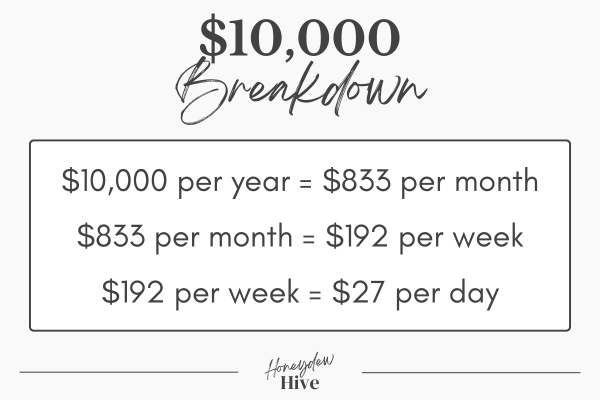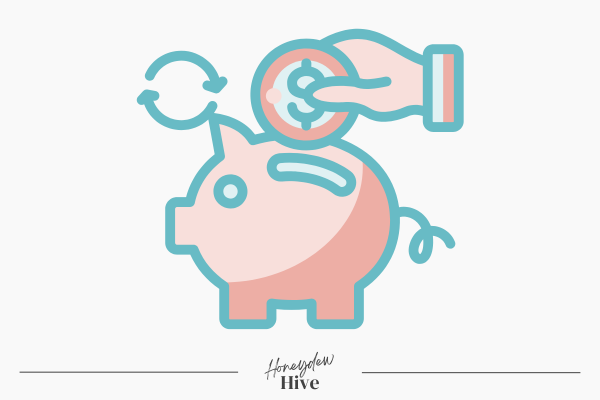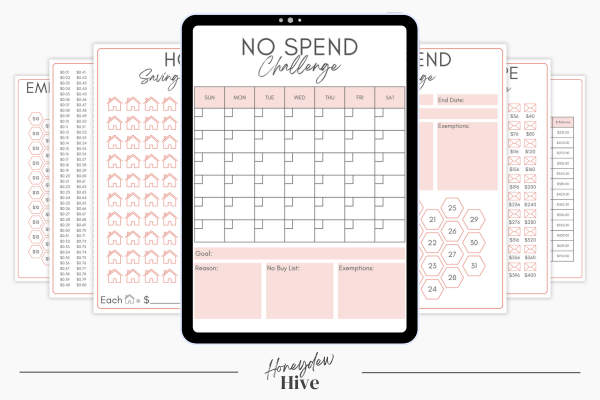How to Save $10,000 This Year (Even on a Tight Budget)

Saving money can feel overwhelming, especially when you’re already stretched thin. The idea of setting aside $10,000 in just one year might sound impossible, but with the right strategy, it’s more achievable than you think.
The key to reaching a big savings goal isn’t about extreme frugality or cutting out everything you enjoy.
Instead, it’s about breaking the goal down into manageable steps, finding creative ways to save, and making small, consistent changes that add up over time.
In this guide, I’ll walk you through a step-by-step plan to help you save $10,000 in a year, even if you’re on a tight budget.
Whether you’re saving for an emergency fund, a down payment, or a financial cushion, these strategies will help you get there faster.
Why Saving $10K is Achievable (Even on a Tight Budget)
At first glance, saving $10,000 in a year might seem out of reach, especially if you’re already living paycheck to paycheck. But when you break it down into smaller, daily or weekly amounts, it becomes much more manageable.
- $10,000 per year = $833 per month
- $833 per month = $192 per week
- $192 per week = $27 per day
Rather than focusing on the total amount, shifting your mindset to these smaller, more achievable targets makes saving feel less overwhelming.

Instead of stressing over how to come up with five figures, you can focus on saving just $27 a day or finding ways to free up $192 per week in your budget.
For example, skipping a takeout meal, canceling an unused subscription, or using a cashback app for your everyday purchases could easily contribute to your daily savings goal.
Small, consistent actions over time will help you build toward that $10,000 total without feeling like you’re making drastic lifestyle sacrifices.
By breaking it down this way, you can see that saving $10K isn’t about making one huge change—it’s about making a series of small, intentional decisions that add up over time.
Step-by-Step Plan to Save $10,000 in a Year
Now that you understand how saving $10,000 is more achievable when broken down into smaller amounts, it’s time to create a plan.
A goal without a plan is just a wish, and the key to success is being intentional with your savings strategy.
Below are five practical steps to help you reach your goal, even if you’re on a tight budget.
Step 1: Set a Goal & Create a Plan
Saving money doesn’t happen by accident—it requires a clear goal and a strategy to get there. The first step is to decide why you’re saving $10,000.
Whether it’s for an emergency fund, a home down payment, or financial security, having a specific reason will keep you motivated.
Once you set your goal, track your progress so you can stay accountable. A simple savings tracker will help you see how much you’ve saved, how much you still need, and whether you’re on track to hit your target.
Visualizing your progress can keep you engaged and excited about reaching your goal.
To make tracking simple, grab my Mega Savings Challenge Bundle—a fun and effective way to stay motivated and celebrate your progress along the way.
Step 2: Automate Your Savings
The easiest way to build savings without having to think about it is to automate the process.
Set up an automatic transfer from your checking account to a dedicated high-yield savings account every payday. Even a small, consistent transfer adds up over time.
A high-yield savings account earns more interest than a traditional savings account, which means your money will grow faster.

Consider opening an account with Ally or Marcus by Goldman Sachs—both offer competitive interest rates with no monthly fees.
By automating your savings, you take the decision-making out of the process and ensure that saving is a priority, not an afterthought.
Ready to Finally Take Control of Your Money?
The Budget Reset Bundle gives you everything you need to stop the paycheck-to-paycheck cycle, create a real budget that actually works, and start saving fast. No fluff — just real tools for real change.

Step 3: Cut Expenses & Redirect the Savings
If you feel like there’s no extra money in your budget to save, small expense cuts can make a big difference. Here are some practical ways to free up extra cash:
- Meal Plan & Cook at Home – The average household spends hundreds per month on dining out. Cutting just a few restaurant meals per week can save $50+ per week or $200+ per month.
- Cancel Unused Subscriptions – Review your bank statements for memberships you no longer use. Even canceling one $15/month subscription adds up to $180 per year.
- Use Cashback & Rewards Apps – Earning cash back on purchases is an easy way to save extra money. Apps like Rakuten, Fetch, and Ibotta give you money back on groceries, online shopping, and everyday purchases.
Redirect the money you save from these small changes directly into your savings account so it doesn’t get absorbed into daily spending.
Step 4: Find Ways to Increase Your Income
If cutting expenses isn’t enough to reach your savings goal, the fastest way to speed up your progress is to increase your income. Even an extra $200-$500 per month from a side hustle can significantly boost your savings.
Here are a few side hustle ideas to consider:
- Freelancing – Platforms like Upwork and Fiverr make it easy to find clients for writing, graphic design, virtual assistance, and more.
- User Testing & Surveys – Earn extra cash by testing websites and apps through UserTesting or completing surveys on platforms like Survey Junkie.
- Selling Digital Products – If you enjoy creating printables, planners, or spreadsheets, selling them on Etsy can generate passive income.
RECOMMENDED READ: 10 Profitable Side Hustles You Can Start This Weekend
By putting 100% of your side hustle earnings toward your $10,000 savings goal, you can cut the time it takes to reach your target in half or more.
Step 5: Use a Savings Challenge to Stay Motivated
Saving money can feel like a long, slow process—but a savings challenge can make it fun and rewarding. A structured challenge gamifies the process, helping you stay consistent and on track.
For example, my Mega Savings Challenge Bundle includes multiple challenge formats, such as:
- $667.95 Penny Challenge – Helps you start small to build motivation.
- 52-Week Challenge – Save a set amount each week.
- No-Spend Challenge – Cut unnecessary spending and redirect the savings.
Using a challenge keeps you engaged and excited about saving, turning it into a habit rather than a struggle.
Overcoming Common Obstacles
Even with a solid savings plan, many people struggle to stay on track due to common roadblocks.
If you’ve ever felt like saving money just isn’t possible for you, you’re not alone. Here’s how to overcome the most common obstacles that can derail your progress.
Obstacle #1: “I Don’t Make Enough Money to Save”
One of the biggest misconceptions about saving is that you need to have a high income to do it. The reality is that small, consistent changes in how you manage your money can lead to big savings over time.
- Even if you can only set aside $5 per day, that adds up to $1,825 per year—almost 20% of your goal.
- Using cashback apps, cutting unnecessary expenses, and picking up a small side hustle can help you find extra money without making drastic lifestyle changes.
- The key is to start with what you can and increase your savings over time.
It’s not about having extra money lying around—it’s about being intentional with every dollar you earn.
Obstacle #2: “I Always Forget to Save”
If saving isn’t already part of your routine, it’s easy to forget about it until the end of the month—when there’s nothing left to set aside.
The best way to solve this problem is to automate your savings so you don’t have to rely on willpower.

- Set up automatic transfers from your checking account to a savings account as soon as you get paid. Treat it like a bill so you don’t have to think about it.
- Use a savings tracker to keep yourself motivated and accountable. My Mega Savings Challenge Bundle makes it easy to track your progress and stay on course.
- Set calendar reminders or alerts on your banking app to review your savings progress at the end of each month.
When you take the decision-making out of the process, saving becomes effortless.
Obstacle #3: “Emergencies Keep Ruining My Savings”
Unexpected expenses—like car repairs, medical bills, or home maintenance—can wipe out your savings if you’re not prepared.
The best way to prevent setbacks is to build an emergency fund alongside your savings goal.
- Start by setting aside at least $500 to $1,000 in a separate emergency fund to cover unexpected costs.
- Keep this money in a high-yield savings account so it’s accessible but not tempting to spend.
- Once you have a safety net, you can save for your $10,000 goal without worrying about setbacks.
Having an emergency fund doesn’t just protect your savings—it gives you peace of mind, knowing that a financial surprise won’t completely throw you off track.
Final Thoughts: How to Save $10,000 in a Year
Saving $10,000 in a year might seem like a big challenge, but it’s absolutely possible—even on a tight budget. The key is to break it down into manageable steps, stay consistent, and use the right strategies to make saving easier.
By setting a clear goal, automating your savings, cutting unnecessary expenses, increasing your income, and using a savings challenge to stay motivated, you’ll be surprised at how quickly your savings add up.
Even if you can’t save the full $10,000 right away, starting with small, intentional changes will put you on the right path.
The most important step is to start today. Don’t wait for the “perfect time” or for your financial situation to magically improve—taking action now will set you up for long-term success.
To make it even easier, grab my Ultimate Budget Makeover Planner—a free resource designed to help you create a savings plan, track your progress, and stay motivated.
Download it now and take the first step toward hitting your savings goal this year!


